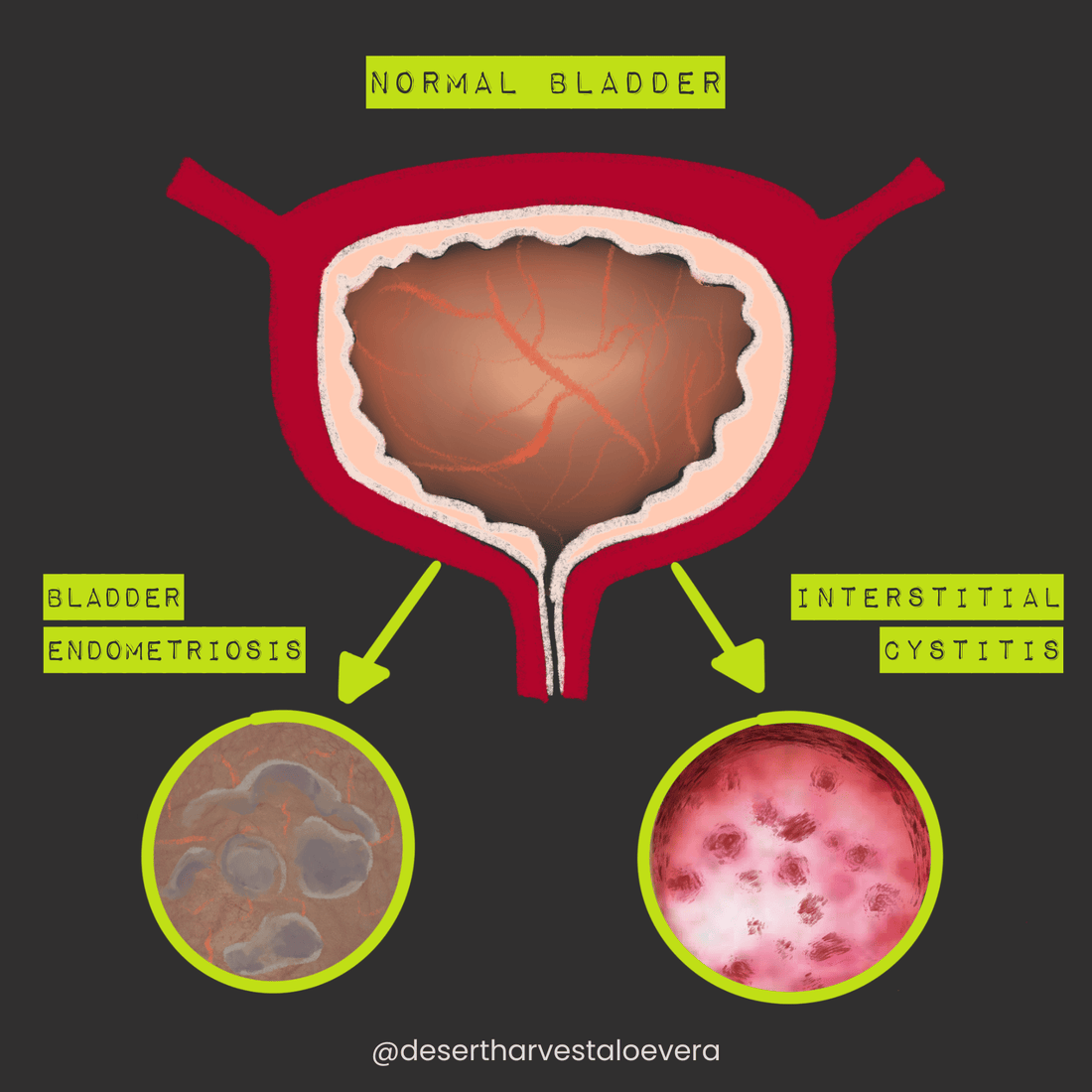
Bladder Endometriosis vs. Interstitial Cystitis: What’s the Difference?
Two Conditions, One Shared Struggle: Let’s Break It Down
Bladder Endometriosis vs. Interstitial Cystitis:
The Evil Twins 👯♀️
If you’re dealing with chronic bladder pain, urgency, or pressure, and struggling to find clear answers, you’re not alone. It’s a challenge many people with pelvic pain know all too well. Often, they receive multiple diagnoses over time or, frustratingly, go years without one at all. This leads many to ask: What is the difference between Bladder Endometriosis vs. Interstitial Cystitis?
Bladder endometriosis and Interstitial Cystitis (IC/BPS) are two conditions that are often confused. Although they can share similar symptoms, they are not the same. Understanding the key differences between them is essential. It will pave the way to more accurate diagnoses, targeted treatment options, and—most importantly—lasting relief.
At Desert Harvest, we’re committed to walking alongside you on your wellness journey. That’s why we offer natural, clinically backed solutions that support bladder health and help you feel more like yourself again.
What Is Bladder Endometriosis?
Bladder endometriosis is a specific form of endometriosis in which endometrial-like tissue grows on or inside the bladder. It helps first to recognize how this tissue behaves to understand this condition better. Like the uterine lining, it thickens, breaks down, and bleeds in sync with the menstrual cycle. Unlike a typical period, this misplaced tissue has nowhere to go. As a result, it becomes trapped within the body, which can lead to chronic inflammation and significant pelvic pain. In some cases, scarring of the surrounding tissues.
Moreover, because the bladder is involved, symptoms often mimic those of other bladder conditions, making diagnosis even more challenging. Recognizing the signs early and seeking informed care is vital for long-term relief.
Common Symptoms of Bladder Endometriosis:
- Pelvic pain that worsens with the menstrual cycle
- Painful urination
- Blood in the urine (especially during menstruation)
- Pain during intercourse
- Bladder pressure or frequency
Diagnosis often requires imaging, cystoscopy, or laparoscopic surgery to confirm.
What Is Interstitial Cystitis (IC)?
Interstitial Cystitis (IC) is also known as Bladder Pain Syndrome (BPS). It is a chronic condition characterized by recurring bladder pain, pressure, and an urgent, frequent need to urinate. Unlike bladder endometriosis, IC is not caused by endometrial tissue. Instead, it is believed to result from a breakdown of the bladder lining, nerve dysfunction, or an autoimmune response.
It’s important to note that some women are affected by both conditions together, which further complicates diagnosis and treatment. Understanding the distinctions between these two conditions is crucial to finding the right path to symptom relief.
Common Symptoms of Interstitial Cystitis (IC):
- Urinary frequency (even up to 60 times a day in severe cases)
- Bladder pressure and pain
- Painful intercourse
- Flare-ups triggered by foods, stress, or hormonal changes
- Relief after urination
- IC is often diagnosed after other conditions are ruled out.
Let’s Compare the Differences Between IC/BPS and Bladder Endometriosis

Similar Symptoms, Different Causes
It’s easy to see why these conditions are mistaken for one another. Both can cause:
- Bladder pain and urgency
- Pelvic discomfort
- Pain with intimacy
- Life-disrupting flares
These symptoms often stem from different underlying causes and need different treatment approaches. Some patients even have both conditions, making diagnosis and treatment layered.
🩺 Diagnosis and Treatment
Diagnosis typically involves:
- Medical history review and symptom assessment
- Imaging tests: Ultrasound or MRI to detect lesions.
- Cystoscopy: A procedure using a scope to view the inside of the bladder.
- Laparoscopy: A minimally invasive surgery to confirm and sometimes treat endometriosis.
Treatment options include:
- Hormonal therapies: To suppress endometrial tissue growth.
- Surgical intervention: Removal of endometrial lesions from the bladder wall.
- Pain management: Medications and lifestyle changes to alleviate symptoms.
Early diagnosis and a multidisciplinary approach are crucial for effectively managing bladder endometriosis.
Managing Pain and Finding Relief
Whether you’re navigating bladder endometriosis, IC, or both, you deserve relief and support. At Desert Harvest, we believe in natural, science-backed solutions to help you take control of your bladder health.
Here’s what can help:
💧 SSAV Capsules
Clinically shown to help reduce bladder inflammation and promote healing of the bladder lining, especially for those with IC/BPS.
🌼 Releveum® Topical Cream
With 4% Lidocaine and natural botanicals, this cream provides fast, localized relief for pelvic and vulvar pain.
🍽️ Diet and Lifestyle Tools
Our bladder-friendly food guides, pH-balanced personal care products, and educational resources help reduce flares and restore balance.
You Are Not Alone
Chronic pain can be isolating, but there’s a community here that genuinely understands what you’re going through. Whether you’ve just been diagnosed, suspect bladder endometriosis or IC, or are still searching for answers, your experience is valid. You deserve care that sees the whole picture. Our team is here with evidence-based products and support every step of the way.
Looking for IC/BPS- and Endo-Safe Products?
Shop Our Bladder Health Collection →
